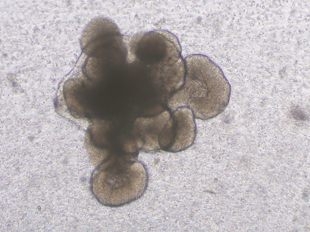オーダーメイド獣医療実現のための早期診断システムおよび新規治療技術の開発

メンバー: 臼井達哉、佐々木一昭
分野: 動物生命科学、基礎医学、薬学
所属: 獣医薬理学研究室
キーワード: がん、オルガノイド、獣医薬理、シグナル伝達、非アルコール性脂肪肝炎、薬物動態、がん超音波療法
ウェブサイト:
研究概要
獣医薬理学研究室では、現在以下の研究テーマを中心に研究を行っています。
- がん三次元培養に関する研究
近年、三次元の上皮組織構造を培養ディッシュ上で再現する方法としてマトリゲル三次元培養法(オルガノイド培養法)が開発されました。オルガノイド培養法によって、様々な組織の上皮細胞を三次元的に長期培養出来ることが示され、がん研究への応用が始まりました。
当研究室では、前立腺がん罹患犬の尿サンプルを用いて前立腺がんオルガノイドを作製する方法を見出し(Usui et al., Cancer Science, 2017)、このオルガノイドが、生体内のがん微小環境を高いレベルで再現できること、免疫不全マウスの体内で腫瘍を再形成すること、抗がん剤および放射線に対する感受性試験への応用が可能であることを明らかにしました。
また、ヒト、がんモデルマウス、犬由来の様々な組織(肺、大腸、前立腺、膀胱、海馬、肝臓)からオルガノイドを作製し、病態解析を行うことで新たながんを含めた様々な病態メカニズム解明や診断マーカーの開発を目指しています。
- 薬物動態に関する研究
当研究室では薬物を投与した様々な動物から採血を行い、高速液体クロマトグラフィーを用いて血漿中薬物濃度を測定した後に、コンパートメント解析によって数式に基づいた動物毎の適切な投与計画の確立を目指しています。近年、抗菌剤の多用によってさまざまな薬剤耐性菌の出現が問題となっており、多くの動物種での体内動態に関する情報が求められています。私達の研究成果は、これらの課題を解決する一助になる可能性があります。
- がん超音波療法に関する研究
超音波治療はがんにおいて低侵襲かつ低コストな治療法として近年注目されており、私達は、超音波療法の獣医療への応用を目指して研究を行っています。また、深部領域でも使用可能な新規超音波療法についても開発を進めています。

主要論文・参考事項
- Elbadawy M & Usui T et al., Establishment of a novel experimental model for muscle-invasive bladder cancer by using dog bladder cancer organoid culture. Cancer Sci. accepted. 2019.
DOI: 10.1111/cas.14118 - Usui T et al., Hedgehog Signals Mediate Anti-Cancer Drug Resistance in Three-Dimensional Primary Colorectal Cancer Organoid Culture. Int J Mol Sci.19: E1098. 2018.
DOI: 10.3390/ijms19041098 - Elbadawy M & Usui T et al., Development of an Experimental Model for Analyzing Drug Resistance in Colorectal Cancer. Cancers.10: E164. 2018.
DOI: 10.3390/cancers10060164 - Usui T et al., Preparation of human primary colon tissue-derived organoid using air liquid interface culture. Curr Protoc Toxicol. 75:22.6.1-22.6.7. 2018.
DOI: 10.1002/cptx.40 - Usui T et al., Establishment of a dog primary prostate cancer organoid using the urine cancer stem cells. Cancer Sci. 108:2383-2392. 2017.
DOI: 10.1111/cas.13418 - Usui T et al., Establishment of a novel three-dimensional primary culture model for hippocampal neurogenesis. Physiol Rep. 5:e13318.2017.
DOI: 10.14814/phy2.13318 - Usui T et al., Establishment of a Novel Model for Anticancer Drug Resistance in Three-Dimensional Primary Culture of Tumor Microenvironment. Stem Cells Int. 7053872. 2016.
DOI: 10.1155/2016/7053872 - Usui T et al., Histone deacetylase (HDAC) 4 controls neointimal hyperplasia via stimulating proliferation and migration of vascular smooth muscle cells. Hypertension. 63:397-403. 2014.
DOI: 10.1161/HYPERTENSIONAHA.113.01843
お問い合わせ先
東京農工大学・先端産学連携研究推進センター
urac[at]ml.tuat.ac.jp([at]を@に変換してください)
Development of personalized veterinary medicine using an urine sample-derived three dimensional organoid culture method

Research members: Dr. Tatsuya Usui, Dr. Kazuaki Sasaki
Research fields: Animal life science, Basic medicine, Pharmacy
Departments: Laboratory of veterinary pharmacology
Keywords: cancer, organoid, veterinary pharmacology, signal transduction, Nonalcolholic steatohepatitis, pharmacokinetics, cancer ultrasound therapy
Web site:
Summary
The Veterinary Pharmacology Laboratory is currently conducting research focusing on the following research themes.
- Research on cancer three-dimensional culture
In recent years, the Matrigel three-dimensional culture method (organoid culture method) has been developed as a method for reproducing three-dimensional epithelial tissue structures on culture dishes. The organoid culture method has been shown to be capable of three-dimensionally long-term culture of epithelial cells in various tissues, and its application to cancer research has begun.
In our laboratory, we found a method for producing prostate cancer organoids using urine samples from dogs with prostate cancer (Usui et al., Cancer Science, 2017), and these organoids serve to control the cancer microenvironment in vivo. The high level of reproducibility, the reshaping of tumors in immunocompromised mice, and the application to sensitivity tests for anticancer drugs and radiation have been demonstrated.
In addition, organoids are prepared from various tissues (lung, large intestine, prostate, bladder, hippocampus, liver) derived from human, cancer model mice and dogs, and pathological analysis is performed to obtain various pathological conditions including new cancer. We aim to elucidate the mechanism and develop diagnostic markers.
- Research on pharmacokinetics
In our laboratory, blood is collected from various animals to which drug was administered, and after plasma drug concentration is measured using high performance liquid chromatography, we aim to establish an appropriate dosage plan for each animal based on a formula by compartmental analysis. You are In recent years, the emergence of various drug-resistant bacteria has become a problem due to the frequent use of antibacterial agents, and information on pharmacokinetics in many animal species is required. Our research results may help solve these issues.
- Research on cancer ultrasound
Ultrasound therapy has recently been attracting attention as a minimally invasive, low-cost treatment for cancer, and we are conducting research aimed at the application of ultrasound therapy to veterinary medicine. We are also developing new ultrasound treatments that can be used in deep areas.
Reference articles and patents
- Elbadawy M & Usui T et al., Establishment of a novel experimental model for muscle-invasive bladder cancer by using dog bladder cancer organoid culture. Cancer Sci. accepted. 2019.
DOI: 10.1111/cas.14118 - Usui T et al., Hedgehog Signals Mediate Anti-Cancer Drug Resistance in Three-Dimensional Primary Colorectal Cancer Organoid Culture. Int J Mol Sci.19: E1098. 2018.
DOI: 10.3390/ijms19041098 - Elbadawy M & Usui T et al., Development of an Experimental Model for Analyzing Drug Resistance in Colorectal Cancer. Cancers.10: E164. 2018.
DOI: 10.3390/cancers10060164 - Usui T et al., Preparation of human primary colon tissue-derived organoid using air liquid interface culture. Curr Protoc Toxicol. 75:22.6.1-22.6.7. 2018.
DOI: 10.1002/cptx.40 - Usui T et al., Establishment of a dog primary prostate cancer organoid using the urine cancer stem cells. Cancer Sci. 108:2383-2392. 2017.
DOI: 10.1111/cas.13418 - Usui T et al., Establishment of a novel three-dimensional primary culture model for hippocampal neurogenesis. Physiol Rep. 5:e13318.2017.
DOI: 10.14814/phy2.13318 - Usui T et al., Establishment of a Novel Model for Anticancer Drug Resistance in Three-Dimensional Primary Culture of Tumor Microenvironment. Stem Cells Int. 7053872. 2016.
DOI: 10.1155/2016/7053872 - Usui T et al., Histone deacetylase (HDAC) 4 controls neointimal hyperplasia via stimulating proliferation and migration of vascular smooth muscle cells. Hypertension. 63:397-403. 2014.
DOI: 10.1161/HYPERTENSIONAHA.113.01843
Contact
University Research Administration Center (URAC),
Tokyo University of Agriculture and Technology
urac[at]ml.tuat.ac.jp
(Please replace [at] with @.)

